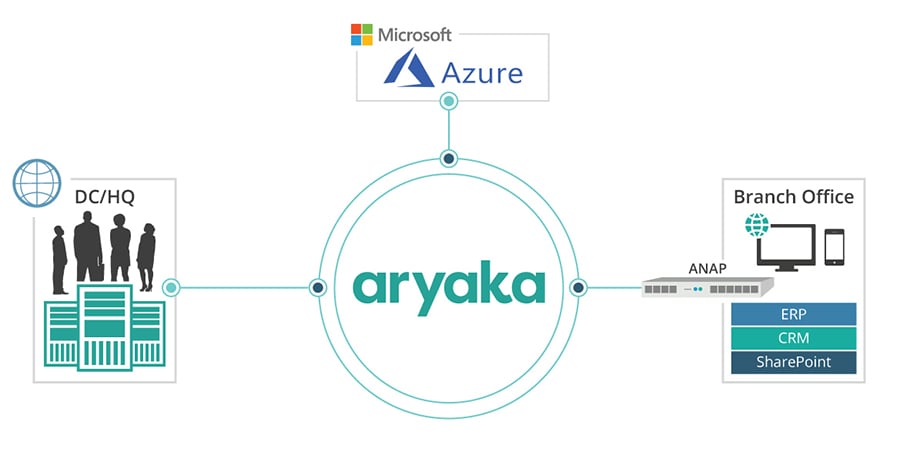Migrating to Azure? The network is critical to deployment success

Microsoft enterprise customers are migrating to the company’s Azure cloud computing platform in droves, with the company reporting 98% year-over-year revenue growth in its second fiscal quarter of 2018.
The appeal is clear. Enterprise shops want to increase agility by getting out of the capital-intensive infrastructure business and start consuming computing as a service on a variable subscription basis. Gartner says total spending on public cloud services will ratchet up 18% this year to $306 billion.
Unfortunately, some organizations anxious to realize cloud benefits don’t adequately examine a key component required for adoption success: the network providing access to the new cloud resources.
Legacy MPLS backbone networks typically don’t have off-ramps to cloud service providers, and using public Internet pipes often results in poor user experiences because of network latency, packet loss, and jitter.
The last thing IT wants when rolling out a shiny new cloud initiative is to have the help desk switchboard light up with complaints about performance.
Why is the Internet Not Good Enough?
Even the best broadband in the world will have issues with reliability and predictability. Thus, while the temptation is often to throw more network bandwidth at an application in an attempt to boost performance speeds, doing so will often fail to solve the fundamental problems.
The reason for this is, generally a poor Internet link exists somewhere in the middle of the connection, rather than the link being poor from beginning to end. The other reason for poor linkage is limited Internet resources at the endpoints, where everybody is competing for access and lack of service-level agreements (SLAs) for specific links.
So, it’s important for enterprises to evaluate the latency, quality of optimization in the network, last mile to identify the true causes of application performance challenges.
What are the Issues with MPLS?
MPLS networks typically have to backhaul traffic to cloud services such as Azure, which often results in slow cloud application performance and poor user experiences.
These problems increase with MPLS when deployments involve international users and long access links. In fact, it’s not uncommon for network problems with MPLS to result in underutilization of cloud resources, which can undermine estimated costs savings used to justify the migration in the first place. In addition, the security, SLA and management requirements associated with disparate traffic flows have add to the complexity of managing branch operations – thus increasing operational (staffing) costs for many IT organizations.
A recognized problem
Microsoft recognizes the problem and offers different ways to help, including Azure ExpressRoute, a way to tie enterprise locations to edge devices in Microsoft’s network. Taking this approach requires the enterprise buyer to do detailed traffic analysis, network design, and rollout connections in a staged manner so issues that crop up can be dealt with at each step of the migration.
This can be a daunting task because the goal of moving to the cloud is to get out of the business of procuring and managing infrastructure. That’s why Microsoft also teams with service providers such as Aryaka to link customer locations to Azure ExpressRoute.
How does Aryaka solves Microsoft Azure performance?
Enterprises can leverage Aryaka’s expertise in a global SD-WAN that is built for cloud platforms, such as Azure, with built-in capabilities including secure private network, application and network optimization (multi-segment TCP optimization, byte-level compression, and Advanced Redundancy Removal technologies), and SD-WAN features such as last mile optimization, application aware routing. This offers seamless and agile integration with the broader global network of enterprises.
Over 800 global enterprises including Samsung, Air China, and Cigna leverage Aryaka’s expertise in global SD-WAN to increase performances to cloud instances such as Microsoft Azure.
Aryaka operates a cloud-native, private WAN with 28 points of presence (POPs) around the world that are within 30 milliseconds of 95% of global business users. The POPs are connected by a meshed Layer 2 network that is fully managed and optimized using patented technology.
Enough with DIY
One of the core benefits of Aryaka’s Global SD-WAN is that it makes it easy for enterprises to adopt cloud services such as Azure and ensure users anywhere in the world to realize fast consistent levels of performance. Aryaka has already built the network, fine-tuned and optimized it (multi-segment TCP optimization, byte-level compression, and Advanced Redundancy Removal technologies), so customers simply consume the network as they do cloud services, on a subscription basis.
If your locations already have Internet access pipes, migrating to Azure can typically be achieved in days by pointing those connections to Aryaka POPs. Aryaka’s Global SD-WAN will transport the traffic securely into Azure data centers via ExpressRoute, completely bypassing the problematic middle mile(s).

Aryaka’s offering is the world’s only Azure ExpressRoute solution that has built-in optimization benefits. This results in much faster access to the Azure cloud, superior and predictable application performance, higher levels of reliability, and enhanced security for customers. What customers have found is that Aryaka is able to deliver a LAN-like experience for all users, even those a continent or an ocean away.
Download the Solution Brief to learn more about how to accelerate Azure performance.







